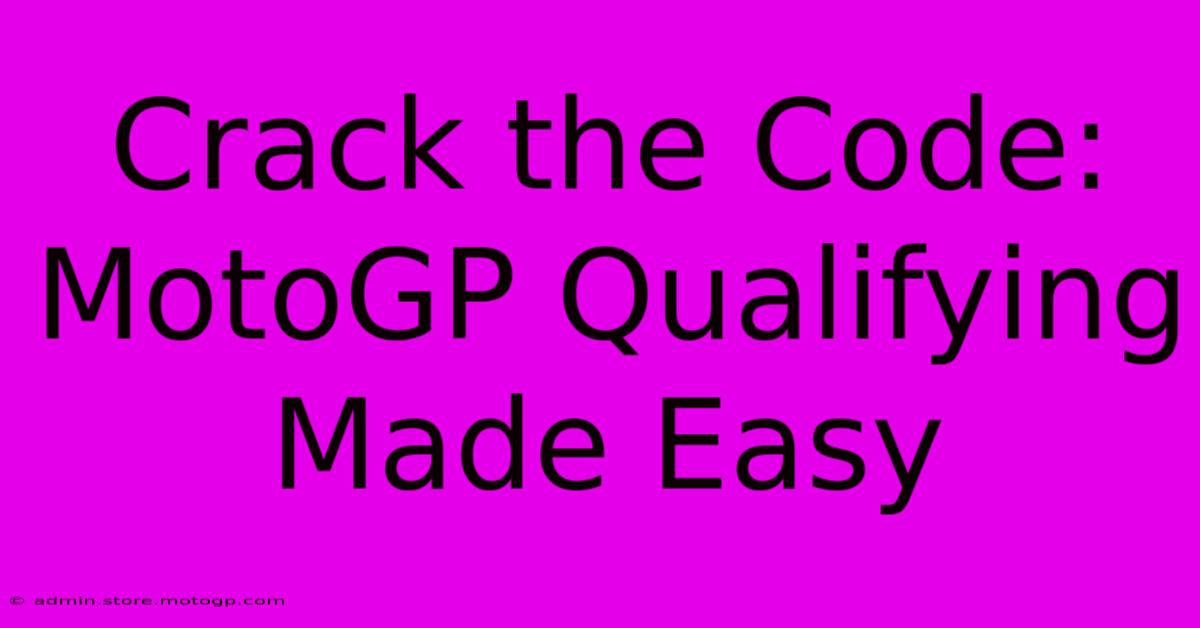Crack The Code: MotoGP Qualifying Made Easy

Table of Contents
Crack the Code: MotoGP Qualifying Made Easy
MotoGP qualifying. The heart-stopping, tire-smoking, last-chance saloon where dreams are made and broken in a frantic 15-minute sprint. Understanding how it works is crucial for any fan wanting to truly appreciate the drama unfolding on track each weekend. This guide will decipher the complexities of MotoGP qualifying, making it easy to understand and even predict the grid.
Understanding the Qualifying Format
MotoGP qualifying is a multi-stage process designed to separate the wheat from the chaff, rewarding consistency and speed. It's not just about a single flying lap; it’s about strategy and adapting to changing track conditions. The process typically unfolds as follows:
1. Free Practice (FP1-FP3):
These sessions are crucial for setting the foundation. Teams gather data, experiment with bike setups, and test different tire compounds. While FP results don't directly determine qualifying positions, they provide vital information and allow riders to get a feel for the track. Fast lap times in free practice often indicate strong qualifying potential.
2. Qualifying 1 (Q1):
The riders who are not within the top 10 combined times from the three free practice sessions start here. This 15-minute session is a high-stakes battle where only the top two riders will advance to Q2. Strategy plays a crucial role; some riders might choose to save tires for a final push while others may go all out from the start.
3. Qualifying 2 (Q2):
This is where the real drama unfolds. The top 10 riders from the combined free practice sessions join the two qualifiers from Q1. This is a 15-minute session to determine the final grid positions for the race. Every tenth of a second counts, and often, the difference between pole position and second place is razor-thin.
Decoding the Strategies
Winning pole position isn't just about raw speed; it's about strategic thinking. Here are some key strategic elements in play:
Tire Management:
MotoGP tires are delicate creatures. Riders must carefully manage their tire wear, balancing the need for fast lap times with the need to have good tires for the race. Using the right tire at the right time is crucial.
Track Conditions:
Track temperature and grip levels significantly influence lap times. Riders and teams must adapt their strategies based on whether the track is hot, cold, dry, or wet.
Slipstreaming (Drafting):
This aerodynamic advantage can shave crucial tenths of a second off a lap time. Riders often work together, taking turns leading and following to improve their lap times. It's a delicate dance and the strategic use of slipstreaming can make or break a qualifying session.
Wind Conditions:
Wind can significantly impact bike performance and lap times. A strong headwind on a straight can cost valuable seconds, so riders often take this factor into account when choosing their lines.
Key Factors Influencing Qualifying Performance
- Rider Skill: Talent and experience are crucial. The best riders can extract the maximum performance from their machines and compensate for less-than-ideal conditions.
- Bike Performance: A well-tuned bike is fundamental. Engine power, chassis balance, and aerodynamics all contribute significantly.
- Team Strategy: The team's ability to make accurate predictions and implement a sound strategy is equally as important as the rider's skill. Good teamwork is key to success.
- Track Conditions: Changes in track temperature, grip, and wind greatly influence performance.
Conclusion: Beyond the Numbers
While timesheets provide a clear overview, truly understanding MotoGP qualifying involves deciphering the subtle strategies, the rider's skill, and the impact of environmental factors. By considering these elements, fans can move beyond simply watching the race and gain a deeper appreciation for the complexity and excitement of this crucial stage of a MotoGP weekend. It's a blend of science, precision, and nerve that makes it so captivating. Now go out there and analyze that next qualifying session like a pro!

Thank you for visiting our website wich cover about Crack The Code: MotoGP Qualifying Made Easy. We hope the information provided has been useful to you. Feel free to contact us if you have any questions or need further assistance. See you next time and dont miss to bookmark.
Featured Posts
-
Austin Gp 2025 The Ultimate Fan Guide
Feb 18, 2025
-
Moto Gp Sprint Race A Must See For Motorsport Fans
Feb 18, 2025
-
Cota Parking Lost And Found Services
Feb 18, 2025
-
Moto Gp Qualifying From Zero To Hero
Feb 18, 2025
-
Moto Gp Race Tracks An Insiders Look At Track Preparation
Feb 18, 2025
